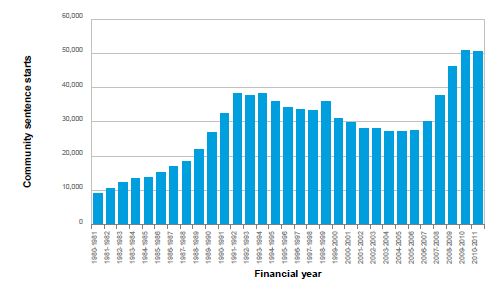8 Community sentenced throughput
8.1 Overview
Information is provided here on the number of episode starts on community sentences. Offenders have been allocated to a single management category, on any one day, even when they have concurrent but different sentence types. This means that an offender start represents a transition from one major management status to another. If an individual has several different community sentences that completely overlap in time-frames, this is treated as a single episode and only a single episode start is counted. However, if an individual has a period of remand in the middle of a single community sentence, there are two distinct episodes of community sentence management, separated by an episode of remand management.
8.2 Overall trend

For more details see: Data Spreadsheet
8.3 Community sentence episode starts — management category

For more details see: Data Spreadsheet, Major management category - 12 Data definitions and groupings
The graphs above make evident the introduction of community work sentences in 2002. These replaced all prior community sentence types, other than supervision. Also, the start up of the new community sentences of home detention, community detention and intensive supervision in 2007 can be seen.
8.4 Community sentence episode starts — offence group

For more details see: Data Spreadsheet, Offence grouping - 12 Data definitions and groupings
The majority of offenders on community sentences have committed good order offences, burglary, theft and fraud offences, and assault and intended harm.
A small component of the observed growth may also be attributed to diversion of short-term prisoner candidates onto the new community sentences.

Note that between 1989 and 1999 there were approximately 10,000 records where the offence group imported / recorded in Corrections’ database was “Unknown”.

